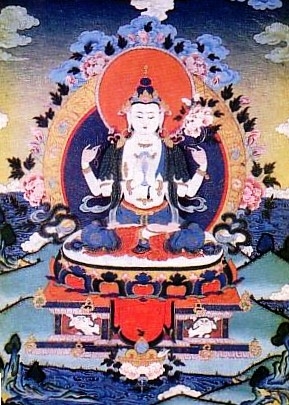Avalokiteshvara: Difference between revisions
Jump to navigation
Jump to search
mNo edit summary |
|||
| Line 16: | Line 16: | ||
*Chaturbhuja | *Chaturbhuja | ||
*Jinasagara (Wyl. ''rgyal ba rgya mtsho'') | *Jinasagara (Wyl. ''rgyal ba rgya mtsho'') | ||
*Shadakshrilokeshvara (Wyl. spyan ras gzigs phyag bzhin pa'') | *Shadakshrilokeshvara (Wyl. ''spyan ras gzigs phyag bzhin pa'') | ||
*Rakta Lokeshvara | *Rakta Lokeshvara | ||
====One Face and Eight Arms==== | ====One Face and Eight Arms==== | ||
*Amoghapasha (Wyl. ''don shags'') | *Amoghapasha (Wyl. ''don shags'') | ||
Revision as of 06:53, 9 September 2009

Avalokiteshvara (Skt. Avalokiteśvara; Tib. Chenrezik; Wyl. spyan ras gzigs) is said to be the essence of the speech of all the buddhas and incarnation of their compassion. As one of the Eight Great Close Sons, he is usually depicted as white in colour and holding a lotus. He is of special importance to Tibetans, so much so that he is sometimes described as the patron deity of Tibet. Among his emanations are King Songtsen Gampo — who is credited with authoring the Mani Kabum, a cycle of teachings and practices dedicated to the deity — as well as the lineages of Dalai Lamas and Karmapas.
Forms
Masculine Forms
One Face and Two Arms
- Lokanatha (Wyl. 'jig rten mgon po)
- Khasarpana or Khasarpani
- Padmanarteshvara (Wyl. padma gar gyi dbang phyug)
- Nilakhanta
- Padmapani
- Simhanada (Wyl. seng ge nga ro)
- Tailokyavashamkara
- Vajradharma (Wyl. rdo rje chos)
One Face and Four Arms
- Chaturbhuja
- Jinasagara (Wyl. rgyal ba rgya mtsho)
- Shadakshrilokeshvara (Wyl. spyan ras gzigs phyag bzhin pa)
- Rakta Lokeshvara
One Face and Eight Arms
- Amoghapasha (Wyl. don shags)
Three Faces
- Chintachakra
Eleven Faces
- Ekadashamukha (Wyl. bcu gcig zhal)
- Sahasrabhujalokeshvara (Wyl. phyag stong zhal bcu gcig)
- Vajragarbha
Feminine Forms
- Guanyin (Chinese)/Kannon(Japanese)
Further Reading
- Jamgön Mipham, A Garland of Jewels, (trans. by Lama Yeshe Gyamtso), Woodstock: KTD Publications, 2008.
- Bokar Rinpoche, Chenrezig, the Lord of Love , Clearpoint Press, 1991.
- John Blofeld, Bodhisattva of Compassion—The Mystical Tradition of Kuan Yin, Shambhala, 1988.